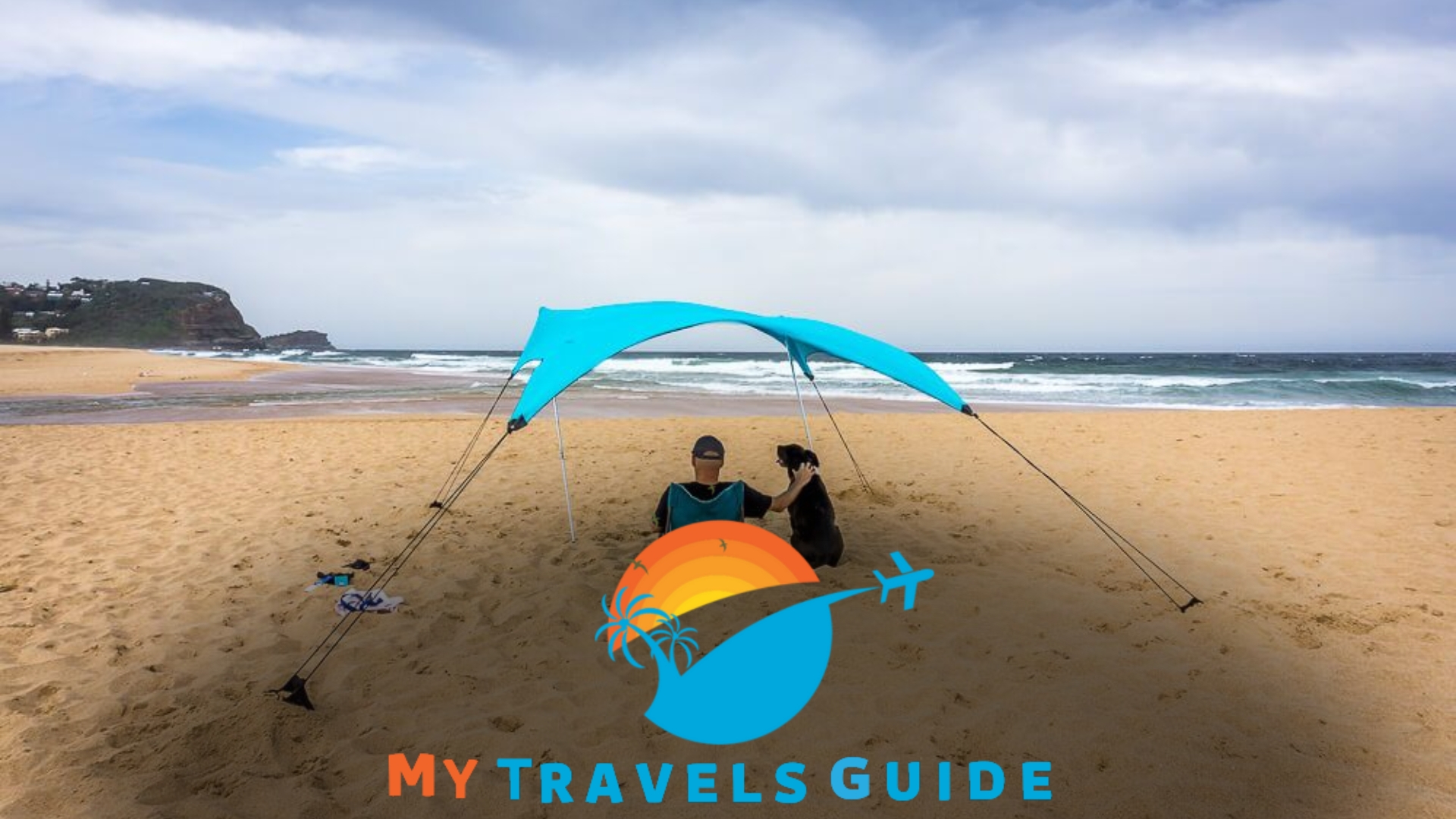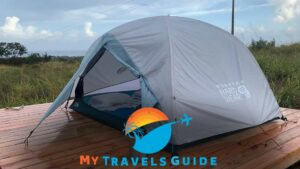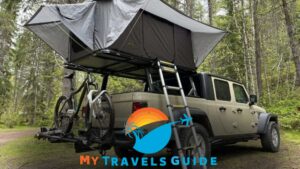In this article:
To cool a tent with electricity, you can use a fan or an air conditioning unit specifically designed for camping. These devices circulate the air and lower the temperature inside the tent.
You can also use a portable evaporative cooler or misting fan that cools the air through evaporative cooling techniques.
Another option is to connect your tent to a power source and use a portable mini-fridge or cooler to store cold drinks and food, relieving the heat.
Camping in a tent during hot weather can be uncomfortable without proper cooling techniques. While nature enthusiasts often seek the tranquility of the great outdoors, they don’t have to sacrifice comfort entirely.
You can effectively cool your tent and create a more pleasant camping experience by utilizing electricity.
We will explore different methods of cooling a tent with electricity, including fans, portable air conditioning units, evaporative coolers, and even portable refrigeration systems.
So whether you’re planning a summer camping trip or seeking relief during a heatwave, read on to discover how to beat the heat and stay cool in your tent.
Understanding the Camping Environment
Understanding the camping environment is crucial for effective temperature control in tents. Various factors influence the temperature inside a tent, including the weather conditions, the location of the campsite, and the amount of shade available.
During hot summer days, the temperature inside a tent can quickly rise, making it uncomfortable for campers.
However, cooling a tent and creating a more pleasant camping experience with electricity is possible. Portable electric fans and air conditioners can circulate air and lower the temperature.
Proper insulation, ventilation, and shade can also play a significant role in keeping the tent cool.
By considering these factors and implementing the right strategies, campers can enjoy a refreshing and comfortable camping experience even during hot weather conditions.
Explore our guide on essential techniques, including proper ventilation and gear choices, to discover how to keep your tent dry inside during unpredictable weather conditions, ensuring a cozy and moisture-free camping environment.
Choosing the Right Electric Cooling Methods
Choosing the right electric cooling methods for your tent is essential for a comfortable camping experience. Portable air conditioning units are popular, providing direct and efficient cooling.
Evaporative coolers are another option, using water to lower the temperature naturally.
Fans and ventilation systems can also help circulate air and create a cooling effect. When deciding on an electric cooling method, consider factors such as the size of your tent, the power source available, and the climate you will be camping in.
You can beat the heat and enjoy a refreshing environment inside your tent by selecting the appropriate cooling method. Stay cool and comfortable during your camping adventures with these electric cooling solutions.
Setting Up and Operating Electric Cooling Systems
Setting up and operating electric cooling systems for tents involves determining power source requirements, installing and placing the cooling devices properly, and optimizing airflow and circulation.
Before starting, it is important to assess the power needs of the cooling system based on the device’s specifications.
Once you have determined the power requirements, ensure access to a reliable power source, such as a portable generator or a power outlet. When installing the cooling device, place it strategically in the tent to maximize its effectiveness.
Consider tent size, proximity to sleeping areas, and ease of access—lastly, open windows or vents for proper ventilation to optimize airflow and circulation. Use fans or other accessories to create a steady airflow within the tent.
Following these steps, you can cool your tent efficiently and enjoy a comfortable camping experience.
Ensuring Safety And Efficiency
Using electrical appliances and devices safely is crucial for ensuring the safety and efficiency of cooling a tent with electricity. Conserving energy and maximizing cooling efficiency is important when using appliances and devices designed specifically for camping.
Understanding the limitations of the power source and the potential risks involved is necessary to avoid overloading the electrical system and causing accidents.
Always follow the manufacturer’s instructions for each appliance or device, and never leave them unattended.
It is also a good practice to unplug the appliances when not in use to prevent any potential electrical hazards. These measures will keep you safe and help you enjoy a cool and comfortable camping experience.
Planning an extended camping trip? Dive into our comprehensive guide to find the best tent for long-term camping, covering factors like durability, space, and features to make your camping adventure comfortable and enjoyable.
Alternative Cooling Methods for Camping
Camping in the heat can prove challenging, but alternative tent cooling methods exist. One option is utilizing solar-powered cooling solutions, which are environmentally friendly.
Another option is to take advantage of natural shade and ventilation. Look for a campsite with trees or set up your tent near a natural wind source.
You can also stay cool without electricity by using a few helpful tips. Opt for lightweight and breathable fabrics for your bedding and clothing. Stay hydrated by drinking plenty of water and avoid consuming caffeine and alcohol.
Take cooling breaks during the hottest parts of the day by finding shade or going for a swim.
Implementing these strategies lets you enjoy a comfortable and cool camping experience, even without traditional electricity-powered cooling methods.
Frequently Asked Questions
How Can I Cool My Tent Down Without AC?
To cool your tent without AC, try these methods:
- Find shade: Position your tent in a shady area to avoid direct sunlight and reduce heat accumulation.
- Ventilation: Set up fans or open windows and vents to promote air circulation and dissipate heat.
- Use reflective material: Cover your tent with a reflective tarp or emergency blanket to reflect sunlight away.
- Wet towel: Dampen a towel and hang it near the entrance or place it on the roof to create a cooling effect as the breeze passes.
- Stay hydrated: Drink plenty of water to keep your body cool from the inside out.
- Use a solar-powered fan: Consider investing in a solar-powered fan to circulate air inside the tent without relying on electricity.
- Choose cooler hours: Plan your activities when temperatures are lower, such as mornings and evenings.
Remember, while these methods may help lower the temperature, they may not be as effective as traditional air conditioning. Stay comfortable and safe by monitoring your body for signs of overheating.
How Can I Make My Tent Cool?
To make your tent cool, try these tips:
- Opt for a tent with proper ventilation and mesh panels to allow the air to circulate.
- Set up your tent in a shaded area to avoid direct sunlight and excessive heat.
- Use a rainfly or reflective tarp to deflect sunlight away from your tent and keep it cooler.
- Consider using a portable or battery-powered fan to improve air circulation inside the tent.
- Camp near a water source, like a lake or river, if possible, as the evaporation can lower the temperature.
- Use wet towels or a misting bottle to dampen the tent fabric, as evaporation also helps cool.
- Keep the tent zipped up during the day to prevent hot air from entering, and open it at night to allow cool air inside.
- Avoid cooking inside the tent, as it generates heat. Instead, cook outside.
- Lastly, dress appropriately for hot weather and use lightweight, breathable bedding.
Can You Use a Portable AC in a Tent?
Yes, you can use a portable AC in a tent. Portable AC units are designed to provide cool air in small spaces, making them suitable for tent use.
These units are compact, lightweight, and easy to install, creating a comfortable environment inside your tent, even in hot weather.
The portable AC unit draws warm air from the tent, passes it through a cooling system, and then returns the cooled air to the tent. It’s important to ensure your tent is properly insulated and has enough ventilation for the AC unit to work efficiently.
Additionally, it is crucial to have access to a power source, such as an electrical outlet or a generator, to run the AC unit. A portable AC can be a great addition to your camping gear if cool air is important during outdoor adventures.
Is There An Air Conditioner for a Tent?
Yes, there are air conditioners available for tents. These portable and compact AC units are designed for camping and outdoor use. They work by using a battery or being plugged into a power source, like a car or generator.
These AC units usually have adjustable settings and cooling power, providing relief from the heat and humidity inside the tent. They are easy to set up and operate, with user-friendly controls and installation processes.
Some models even have additional features, such as built-in fans or dehumidifiers.
So if you’re planning a camping trip during hot weather and want to stay cool and comfortable in your tent, an air conditioner designed for tents is a great option.
How Can I Cool My Tent Without Air Conditioning?
To cool your tent without air conditioning, use a portable fan, open windows or vents, or use misting systems for a refreshing breeze.
Conclusion
To successfully cool your tent with electricity, it is important to consider your power source, insulation, airflow, and temperature control. Using a reliable generator or power supply, you can ensure a constant flow of electricity to run fans or air conditioning units.
Proper insulation, such as using reflective materials or insulation panels, can help keep the cool air in the tent and prevent heat transfer from outside.
Maximizing airflow through strategically placed fans or ventilation systems can help circulate the cool air and create a more comfortable environment.
Lastly, using temperature control devices such as thermostats or timers can help regulate the temperature inside the tent and make adjustments as needed.
Following these steps, you can enjoy a cool and comfortable camping experience even in the hottest conditions.
Remember always to prioritize safety and ensure proper installation and usage of electrical equipment.









